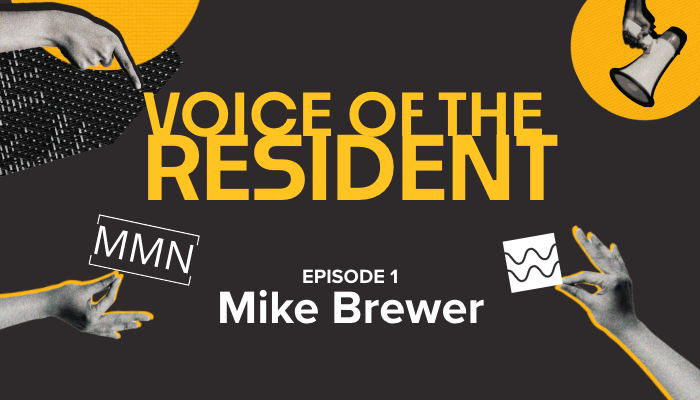-
Products
TechnologyManaged Services
- Resources
- Pricing
- Company
Mike Brewer of Multifamily Collective, Katie Ritter and Jake Hughes of Widewail delve into the evolving landscape of branding in multifamily real estate.

In a recent episode of the Multifamily Collective Podcast, industry expert Mike Brewer (Founder and CEO, Multifamily Collective) alongside Katie Ritter (National Director, Multifamily, Widewail) and Jake Hughes (Director of Marketing, Widewail), discuss how data-driven insights are reshaping multifamily branding and retention strategies.
Brewer's experience offers a seasoned perspective, emphasizing how building brand loyalty in multifamily goes beyond advertising—it's about fostering experiences, understanding feedback, and continuously evolving to meet resident expectations. Listen to the full episode below:
While traditional brand metrics like surveys still have value, resident sentiment data uncovers trends that can offer a fresh perspective. Brewer highlights how this data helps property management companies (PMCs) better understand their brand’s impact in the multifamily sector by leveraging resident feedback—especially through platforms like Google reviews—to measure the effectiveness of their efforts. "Data tells a story that might surprise some folks," he notes.
Typically, brand recognition is gauged through metrics like organic search volume and brand recall surveys, but Brewer sees greater potential in a data-driven, sentiment-focused approach. Ritter and Hughes expand on this by discussing insights from the Voice of the Resident Report, which analyzed over 400,000 Google reviews from the past year, identifying 49 key discussion topics ranging from maintenance to the quality of community spaces.
This data provides an opportunity not only to measure resident satisfaction but also to introduce a "third metric" for assessing brand impact. Brewer emphasizes how resident feedback allows PMCs to pinpoint what matters most to their residents—whether it’s ambiance, safety, or maintenance—enabling them to proactively meet resident needs before issues arise. This, he argues, is key to building long-term loyalty.
Brand mentions in reviews are relatively rare. Only about 1% of reviews in the Voice of the Resident Report mention PMC’s brand by name.
Brewer points out the complexity here: while PMCs may aspire to top-of-mind brand recognition, multifamily residents often don’t know or recall the property management company’s name, instead associating experiences with the community’s name.
“Many times, you have property management companies who own luxury assets or they own workforce housing; they own varying levels of assets. So trying to create cohesion between all of those brands and keep up a consistent brand message is hard,” he says.
He reinforces the idea that PMCs should invest in the quality and consistency of the resident experience rather than fixating solely on brand recall. He sees opportunities to elevate brand reputation through improved resident satisfaction and authentic experiences.
“Your logo is not your brand. Your sign on the side of the building is not [your] brand. It's you, it's me… It's the story you tell about the woman who makes the product or provides the service. That is the brand. And the extent that we can create catalysts for people to tell incredible stories about their time spent and invested in living in a place…that's where you start to really breed brand loyalty,” Brewer says.
Brewer emphasizes a lesser-known yet crucial driver of resident retention: social connectivity. He advocates for what he calls “collision points”—shared spaces designed to facilitate organic resident interactions.
These collision points, whether a bike room, a coworking lounge, or a rooftop fire pit, can become powerful branding tools, subtly increasing brand loyalty by creating positive memories. “Renewal probability is higher when you have a friend or you're friendly with the neighbors,” Brewer says.
This is reflected in the VOR Report as well—Community moves from the 13th most mentioned topic to the 7th during the renewal lifecycle stage.
As Gen Z begins to enter the renter market, the expectations for what a brand should deliver are evolving.
Brewer believes that PMCs will need to become more intentional about how they build and promote their brands, as Gen Z places a higher value on authenticity, community, and experience.
Ritter also touches on this shift, noting that while traditional metrics like cleanliness and safety remain important, Gen Z renters are asking deeper questions. “They’re looking beyond the basics and asking, ‘Who are you as a brand? What do you stand for?” she says. This reflects the evolving expectations, where renters don’t just want a landlord—they want to feel like they’re part of a community that reflects their values and interests.
While Gen Z is more aware of brand authenticity, Brewer mentions they also expect consistent engagement. PMCs that prioritize connection throughout a resident's time at a property, not just during lease signings or move-ins, will be the ones to succeed.
It’s about staying engaged with residents, not just reacting when something goes wrong. Regular, positive touch points—whether through events, services, or even personalized gestures—can make a big difference.
“People are not seeking perfection... People just want their problems solved. But prior to solving, they want to be seen and they want to be heard and they want to be acknowledged and they don't want to be passed off to three people and tell their story three times in order to get to the solution,” Brewer says.
It’s all about honest communication and a clear sense of what your brand stands for. If you can create that level of trust, you’re much more likely to see long-term brand loyalty.
Brewer has long been a supporter of loyalty programs and is excited to see multifamily explore similar models seen in the hospitality industry. He explained how loyalty programs reward residents for good behaviors, like on-time payments, through points that can be redeemed for benefits like credit-building or even financial incentives. Brewer believes these programs have powerful emotional value, as they can meet residents’ needs in ways that go beyond rent discounts.
In Brewer's view, loyalty programs not only incentivize good tenancy behaviors but also create a deeper, emotional connection between residents and PMCs.
“There's a company [that helps] you if you're underbanked or unbanked, they actually help you create the credit history to get yourself banked. And to me, if my community is helping me do that, that's a huge emotional situation, right? It creates emotion that automatically gets attached to you as a property management company because you're assisting that individual in being able to buy a car or buy something for their children,” he says.
Brewer’s decades in the multifamily industry offer a pragmatic view: true branding is about the details of experience management rather than traditional advertising alone.
Branding is a continuous process, with PMCs needing to focus on consistency, transparency, and genuine connection to truly resonate with residents. By using resident sentiment data, building spaces that encourage connection, and even incorporating loyalty programs, PMCs can transform everyday interactions into memorable brand experiences.
Successful multifamily branding is not about top-down messaging; it’s about creating environments where residents feel valued, heard, and supported. PMCs that focus on holistic branding strategies informed by real resident feedback will be the ones that stand out.
Originally from Scarborough, Maine, I moved to Vermont after graduating from St. Lawrence University, where I received my BA in English and Spanish. I have always been interested in writing and communication, which is what initially drew me to the Review Response Specialist position at Widewail. In my spare time, I can be found reading, playing electric guitar, or strolling/biking around one of Burlington’s many scenic trails. I always welcome the opportunity to talk about my work, and invite anyone with questions or comments to reach out or connect with me on LinkedIn.
Bite-sized, to-the-point, trend-driven local marketing stories and tactics.
Automated Review Generation
Video Testimonial Generation

Maintain Accurate Listings

Private Surveys
Review Response Managed Services
Social Media Engagement Services
©Widewail 2025.
U3GM Blog Post Comments